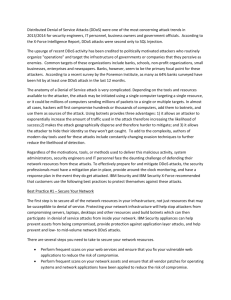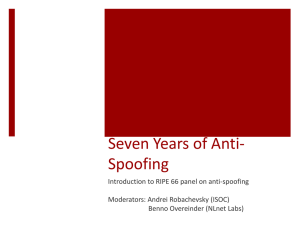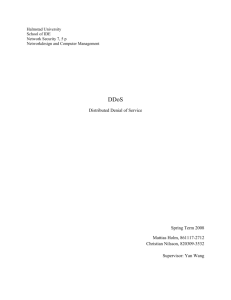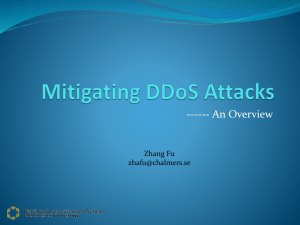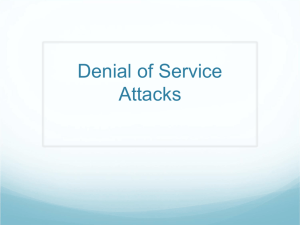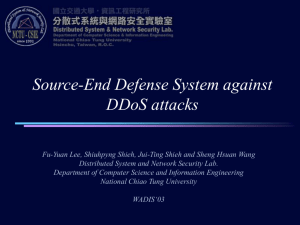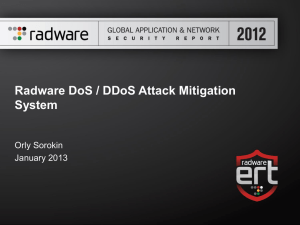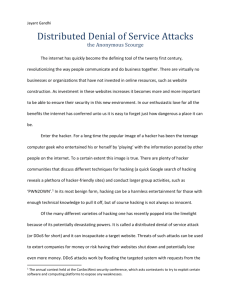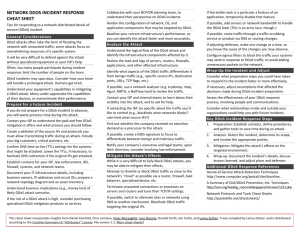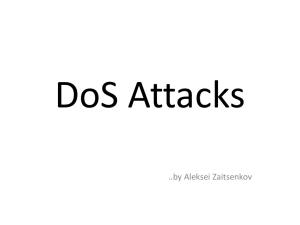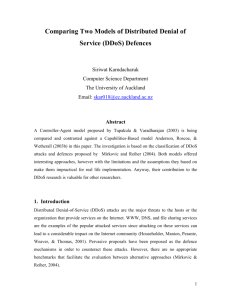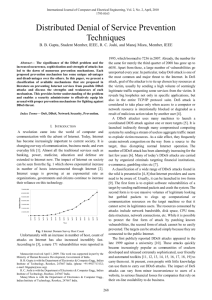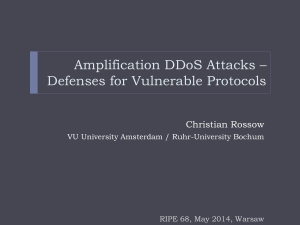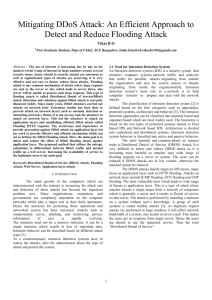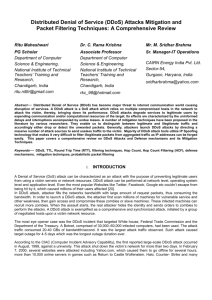Evolution of DDoS
advertisement
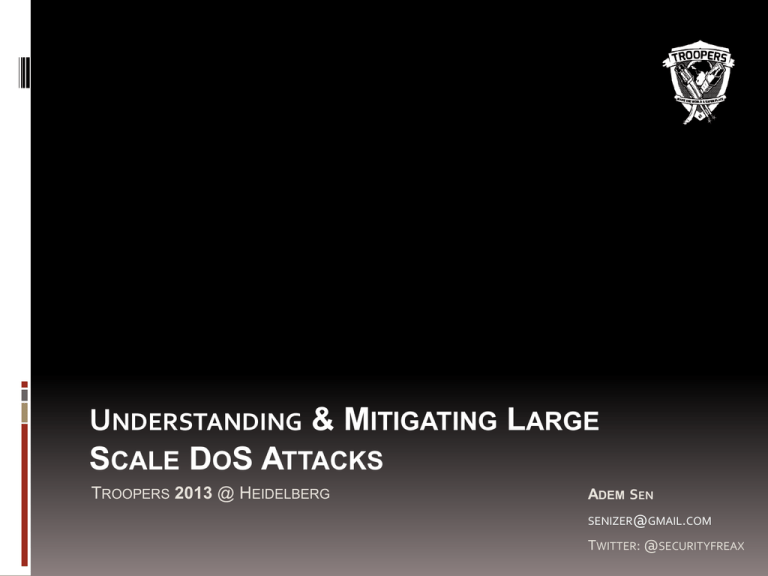
UNDERSTANDING & MITIGATING LARGE SCALE DOS ATTACKS TROOPERS 2013 @ HEIDELBERG ADEM SEN SENIZER@GMAIL.COM TWITTER: @SECURITYFREAX AGENDA PROLOGUE EVOLUTION OF DDOS ATTACK TYPES & TOOLS MITIGATE & RESPOND DDOS MYTHBUSTING EARLY WARNINGS APPENDIX: USEFUL RESOURCES Me and myself Graduation in Software Engineering, > 10 years experience in #INFOSEC 09 - present: Network Security Expert@DB Systel Security-obsessed whitehat, focused on network defense techniques Blood group: “coca cola - positive” Hunting botnets for fun and research purposes, and sometimes for beer & pizza :-) No sponsor! Comments are welcome during talk! For the record… Statements do reflect my very own experiences, some may find consent others may not, you’re welcome! Statements on Firewalls & IPS may result in #VENDOR PANIC Opinions are mine and do not represent those of my employer Scope and Prerequisites I assume that everybody is familiar with TCP/IP networking, we won’t cover it here “Mitigate & Respond” will be covered from a large enterprise’s perspective running its own AS with wide range of dynamic websites Due to time given we will focus on major types of attacks and countermeasures Intentionally skipping SIP / H.323 based attacks and countermeasures, probably in future talks Skipping DNS / Domain and BGP hijacking OK, let’s get started…! :-) Evolution of DDoS - good old… D(DoS) == nothing new at all, but underestimated Covered in various early IETF papers e.g. RFC 2267 / 2827 First (usable) attack tools appeared in the 90‘s (e.g. Teardrop and LAND) Evolution of DDoS - the 90‘s Early attacks (as in 1996) simply targeted weaknesses in TCP/IP implementations CA-1996-21 TCP SYN Flooding Simple packet throwing code, but still working! No reliable command and control (C2) structures Low powered attacks & far away from app-layer (D)DoS == considered as a „side issue“ than as a serious threat Evolution of DDoS - a rude awakening Significant growth of worldwide network traffic Most ISPs missed to implement mitigation techniques Best practices not implemented ISPs don‘t prevent IP spoofing […] No „signaling“ between ISPs, no global / regional network visibility Industry still playing reactive Security tech in place fails to combat DDoS Lack of knowledge / #INFOSEC resources in #COMPANY Evolution of DDoS - game has changed Hacktivists entered the game after Wikileaks disaster Sophisticated #BOTNETs appeared w/ command & control structures - utilizing hundreds of thousands of victims Significant increase of DDoS attacks Today :: DDoS has become Mainstream! Evolution of DDoS - attack sizes DDoS attack sizes are increasing continuously Monitored 100+ Gbps DDoS (max.)1 Average attack size ~ 2 Gbps [1 & Graph] Source ARBOR Networks Worldwide Infrastructure Security Report 2012 Volume VIII) Evolution of DDoS - Motivation & Threats MOST COMMON THREATS MOTIVATION 1 - Attacks towards customer 1 - Political & Ideology services at datacenters 2 - Online Gaming related (yes, 2 - Infrastructure attacks seriously!) (Firewalls, Load balancer) & Services (DNS, Mail) 3 - Vandalism 3 - Misconfiguration (WTF!) Source ARBOR Networks Worldwide Infrastructure Security Report 2012 Volume VIII) ENOUGH BACKGROUND? LET‘S DIVE IN….! Attack types - introducing the big 4 Application Layer Attacks Exhausting system resources, e.g. CPU, memory & sockets HTTP GET/POST flooding is leading this category SlowHTTP attacks belong also to this category Trend: increasing Protocol State Attacks Exhausting state tables of network devices, e.g. firewalls & load balancers Remember: App server are statefull too, due to TCP state machine TCP SYN / RST flooding is leading this category Trend: increasing Attack types - introducing the big 4 Volumetric Attacks Exhausting network bandwidth resources HTTP(S) & DNS leading this category Expensive to engage, other vectors preferred Trend: constant Multi-Vector attacks == more sophisticated Using a blend of attack vectors HTTP(S), DNS, TCP, UDP, ICMP [..] Utilizing compromised web[servers] at hosting facilities to gain more power Trend: increasing & difficult to mitigate! Attack types - tools Well known tools LOIC / HOIC and other boring „press F5“ tools Slowloris.pl Apache killer / Nkiller2 PHP / JavaScript [..] based attack routines …any many other tools / scripts Usage of benchmark / diag tools ab - apache bench Jmeter Hping (powerful!) Most tools invoke same vectors HTTP request flooding TCP / UDP / ICMP flooding NOT exploiting vulnerabilities Attack types - die hard…. Hping: easy to use but powerful at packet flooding Generating ~ 140.000 packets per second (pps) by single „VM“ in the cloud Be careful while playing with hping in the cloud - you‘ve been warned! :-) TCP SYN flooding w/ & w/o spoofing hping3 –S –p 80 --flood –rand-source --tcp-mss 1460 -L syn [IP] hping3 –S –p 80 --flood --tcp-mss 1460 -L syn [IP] Attack types - die hard… ~ 180 kpps of TCP SYN will consume 99.9% CPU on almost every current firewall Tested on ASA 5585X-SSP-60 & CheckPoint 21400 (as of Nov. 2012) CheckPoint published multiqueue IRQ drivers to solve this issue, Firewalls w/o multiqueue drivers are still vulnerable Attack types - killing me softly…. Slow HTTP / slowloris attacks (D)owning powerful websites with less than 1000 kbps Sending HTTP requests byte by byte, but never sending „carriage return” Not exploiting a bug => IDS / IPS won‘t work for this Exhausting sockets to keep server busy Difficult to detect on first contact, low bandwidth, low CPU usage Won‘t be fixed by apache, you have to fix it yourself Apache Modules - mod_security, mod_reqtimeout, mod_antiloris Load Balancers - Advanced TCP splicing & delayed forward Attack types - killing me softly… Profiling the #TARGET for best timeout value to choose slowloris.pl -dns [domain] -port 80 –test 240 seconds is the timeout value for this target Attack slowloris.pl -dns [TARGET] -port 80 -timeout 240 -num 1024 Since Apache doesn‘t log incomplete requests #ADMIN will go crazy as nothing is going to be logged during attack 1318-1543-6904-3877-3811 Mitigate & Respond - make or buy Cloud based solutions use same approaches DNS based, acting as reverse proxy, often limited to http traffic only BGP based, off-ramping traffic, piping it back via GRE, not limited to http Vendors AKAMAI (KONA) CLOUDFLARE PROLEXIC (PLXrouted, PLXproxy, PLXconnect) The #Cloud and I won‘t become friends „Cloudflare outage taking down 785.000 websites“ http://tcrn.ch/WoNueA Mitigate & Respond - make or buy There is no „Buy only“ or „Make only“ solution BUY Involve your ISP to counter volumetric attacks Telekom, Vodafone, […] offering DDoS protection MAKE Build up STAFF, in-house capabilities are crucial Visibility is the key, go for Netflow, analyze traffic behavior Implement purpose build solutions to counter sophisticated DDoS attacks Establish #SIGINT with your ISP Implement & maintain mitigation plans Mitigate & Respond - must have countermeasures Flood detection & blocking (pps per source IP) Packet level authentication for TCP SYN, RST, […] TCP policy based blocking (timer, bytes send period[…]) GEO IP & ASN based blacklisting Very useful during large scale attacks App-Level Rate Limiting (http, dns, [..]) DPI / payload based blocking (RegEx…) Missing Blackholing? BH is not a „mitigation“, at least from customer‘s perspective Ever tried this with packet filters, IPS, WAF, LB‘s? That‘s why we need purpose build #EQUIP Mitigate & Respond - If you ask me… …is doing a great job Hardware based, utilizes Netflow for visibility BGP based mitigation, interacts with your AS Granular Traffic diversion via BGP (/32 announcements) Intelligent countermeasures going far beyond FW & IPS Auto Mitigation capabilities ATLAS, >280 ISPs worldwide feeding ATLAS with stats Works for Enterprise to large ISP It Works! Mitigate & Respond - scrubbing center… Gathering Netflow info from edge routers for visibility and attack detection “Off-ramping” traffic for destination IP of #TARGET only, non attack traffic stays on path “On-ramping” traffic after “scrubbing” back to standard routing path Mitigate & Respond - entering the battle... Mythbusting - common myths FW & IPS can protect against DDoS attacks It won‘t! Do not even try it! :-) CDN will solve the DDoS problem (e.g. AKAMAI KONA) No it won‘t since most sites make use of dynamic content, CDN works only for simple static sites You can counter DDoS with ACL automation?!? Wait…what? ACL jockeying will probably knock you out before the attackers can do „Misconfiguration “ is in the top 3 of “most common threats” Early Warnings Ordinary news / press don‘t work for this Join one of the Information Sharing Alliances (ISAC) ISACs don‘t share information with non-ISAC-people :-) FS-ISAC https://www.fsisac.com/ IT-ISAC https://www.it-isac.org/ Use social media for early warnings Twitter is awesome for this (e.g. #ddos, #malware) Google Alerts for shitstorm detection on the entire web Have a look at free anonymous pasting sites like „Pastebin“ Q&A QUESTIONS? Useful Resources & Links Credits go to „INFOSEC Reactions“ for great GIFs :-) ARBOR Networks Worldwide Infrastructure Security Report http://www.google.com/safebrowsing/alerts/ Related IETF RFCs http://www.shadowserver.org/wiki/pmwiki.php/Involve/GetReportsOnYourNetwork Google Safebrowsing Alerts for Administrators http://atlas.arbor.net/ http://ddos.arbornetworks.com/ Shadowserver - ASN & Netblock Alerting & Reporting Service http://www.arbornetworks.com/research/infrastructure-security-report ARBOR ATLAS & ASERT BLOG http://securityreactions.tumblr.com/ https://tools.ietf.org/html/rfc2827.txt https://tools.ietf.org/html/rfc3631.txt https://tools.ietf.org/html/rfc3882.txt https://tools.ietf.org/html/rfc4732.txt https://tools.ietf.org/html/rfc4987.txt Support the hard working „malware crusaders“ community on Twitter, hunting malware and botnets to make the Internet a safer place! #malwaremustdie
